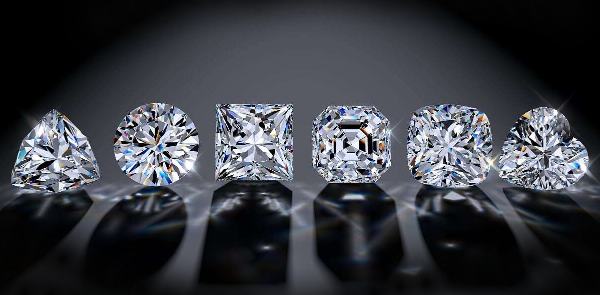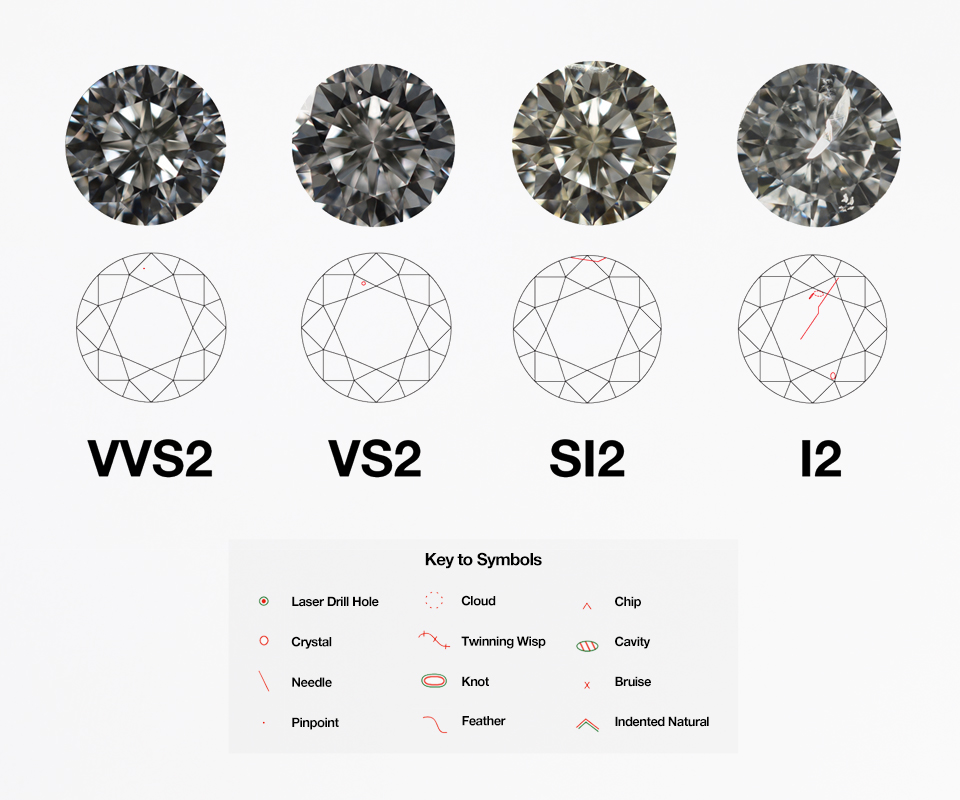In the diamond world, clarity is crucial—it’s one of the main factors in determining a diamond’s quality and value.
So, what does it mean if a diamond is rated as VVS?
VVS stands for “Very Very Slightly Included.” This clarity grade indicates a diamond with incredibly tiny inclusions, so small they’re nearly impossible to see even under magnification. This high level of clarity makes VVS diamonds exceptionally rare and highly prized.
However, understanding VVS isn’t just about knowing the acronym. It means digging into diamond grading, the science of clarity, and what affects the value of these gems.
In this guide, we’ll explain what VVS really means, why it’s valued in the diamond world, and what buyers should know. Whether you’re a diamond fan, a potential buyer, or just curious, this guide will give you a clear look at VVS diamonds.

The Basics of VVS Diamonds
VVS stands for “Very Very Slightly Included.” This clarity grade means the diamond has tiny inclusions, so small they’re hard to spot—even under 10x magnification. To the naked eye, these inclusions are practically invisible.
The VVS grade splits into two levels: VVS1 and VVS2. In VVS1 diamonds, inclusions are usually only visible from the bottom (pavilion). In VVS2, inclusions are slightly more visible from the top (crown), but the difference is minimal.
To understand the value of VVS diamonds, think about the 4Cs: Clarity, Color, Cut, and Carat Weight. While clarity measures internal flaws, the other Cs focus on different qualities. Balancing these factors boosts a diamond’s appeal.
VVS diamonds are rarer than those with lower clarity grades, which adds to their value. Only Flawless (FL) and Internally Flawless (IF) diamonds have higher clarity.
In the market, VVS diamonds stand out for their brilliance and flawless look. Their rarity and clarity make them a prized investment, often fetching premium prices. Jewelry enthusiasts love them for their elegance and superior clarity.

The Science of Clarity: How VVS Diamonds Are Graded
Gemological institutes, like the Gemological Institute of America (GIA), set the standard for diamond clarity. Their expertise ensures that diamonds are graded accurately and consistently across the industry.
Clarity grading is a careful, detailed process. Gemologists use specialized tools and training to evaluate each diamond, examining both internal and surface characteristics to determine clarity.
For VVS diamonds, advanced tools are essential. Gemologists rely on microscopes and 10x magnification loupes to spot the tiny inclusions that define this clarity level.
Several factors affect a diamond’s clarity grade, including the location, size, and type of inclusions. Even the setting and lighting can influence how visible these inclusions are, impacting the final grade.
Understanding how clarity is graded helps buyers appreciate the value of VVS diamonds. This insight can guide them in making smart choices when selecting high-quality stones.

VVS Diamonds in the Jewelry Market
VVS diamonds hold a special place in the jewelry world. With their exceptional clarity, they’re a top choice for buyers looking for high-end engagement rings and fine jewelry.
Celebrities play a big role in boosting demand for VVS diamonds. Many high-profile figures choose these gems to showcase elegance and exclusivity, turning VVS diamonds into symbols of status and sophistication.
Market trends and the economy also affect VVS diamond popularity. Demand can fluctuate based on factors like economic stability and consumer confidence, which influence buying behavior in the diamond market.
Ethical sourcing is increasingly important for today’s buyers, who often seek conflict-free diamonds, including VVS grades. Knowing their diamond is ethically sourced gives consumers peace of mind about their purchase.
The appeal of VVS diamonds goes beyond looks. Market factors and ethical considerations add to their value, making them a compelling choice for both personal enjoyment and investment.

Investing in VVS Diamonds: Key Insights for Buyers
VVS diamonds are an attractive investment choice. Their rarity and quality make them highly desirable, with many seeing them as a stable asset that can appreciate over time.
Certification is essential for VVS diamond investors. A certificate from reputable labs like the GIA confirms the diamond’s authenticity, with detailed reports on clarity, carat, cut, and color—making it easier to make informed decisions.
The cut of a VVS diamond impacts more than its sparkle. A well-cut diamond enhances its beauty and can even minimize the visibility of inclusions, which helps maintain its high clarity and market value.
Resale value is another factor to consider. VVS diamonds with excellent clarity and certification tend to hold their value well, with rarity driving demand and boosting their worth over time.
Investment Tips:
- Look for certification from respected labs.
- Prioritize quality cut for enhanced beauty.
- Think about long-term resale potential.
By focusing on certification, cut quality, and market trends, investors can make smart choices that may maximize value appreciation over time.

Choosing the Right VVS Diamond: A Buyer’s Guide
Picking the perfect VVS diamond comes down to a few key factors: clarity, carat weight, color, and cut.
Start by understanding the difference between VVS1 and VVS2. VVS1 diamonds have slightly fewer visible inclusions under magnification compared to VVS2, but both are exceptional in clarity and look flawless to the naked eye.
The diamond shape affects its brilliance and appearance. Popular shapes like round, princess, and emerald maximize sparkle. Pairing your chosen shape with the right setting can make the diamond shine even more.
Lab-grown vs. natural VVS diamonds is another choice. Lab-grown diamonds are more budget-friendly and offer an ethical alternative while maintaining the same physical and chemical properties as natural diamonds.
Key Tips for Choosing a VVS Diamond:
- Look at clarity, carat, color, and cut.
- Decide between VVS1 and VVS2 based on your preference.
- Select a shape and setting to boost brilliance.
- Weigh the pros of lab-grown versus natural diamonds.
Choosing the right VVS diamond can add both personal and monetary value to your collection. By considering these factors, you’ll find a diamond that brings elegance and sophistication to your jewelry collection.

Caring for Your VVS Diamonds
Keeping your VVS diamonds sparkling takes a bit of care. Regular cleaning removes dirt and oil, preserving their shine. Use a gentle cleanser and a soft brush, and steer clear of harsh chemicals that could harm the metal setting.
Insurance is key for protecting the value of your VVS diamonds. These gems are a big investment, so having coverage can protect against loss, theft, or damage. Talk to an insurance agent who understands jewelry to get the right policy.
Proper storage is also essential. Keep each piece in a separate compartment or soft cloth pouch to prevent scratches. Regular professional inspections can help ensure your diamonds stay in top shape, keeping their beauty and elegance intact.
The Future of VVS Diamonds and the Industry
Advancements in technology are reshaping diamond grading. New tools provide greater accuracy in assessing clarity, including VVS grades. These precise evaluations give buyers added confidence in their purchases.
VVS diamonds have a special place in the luxury market. Their rarity and prestige make them highly sought after for high-end collections. As symbols of status, they continue to attract attention and retain their importance in the industry.
Lab-grown diamonds are also changing the landscape. Synthetic VVS diamonds offer a cost-effective, ethical option. However, their growing popularity could influence demand and perceptions of natural diamonds.
Transparency is vital for the future. Educating consumers about diamond origins and grading builds trust. Clear, honest communication can help stabilize the diamond market for the long run.
FAQ
What does “VVS” mean in diamonds?
“VVS” stands for “Very Very Slightly Included,” indicating a diamond clarity grade with minute inclusions that are extremely difficult to detect under 10x magnification.
How does VVS clarity compare to other grades?
VVS clarity is just below Flawless (FL) and Internally Flawless (IF) grades. It is superior to Very Slightly Included (VS), Slightly Included (SI), and Included (I) grades.
Are VVS diamonds worth the investment?
VVS diamonds are valued for their exceptional clarity and rarity, often commanding higher prices. They can be a good investment, especially if other quality factors like cut, color, and carat are also high.
Can you see inclusions in VVS diamonds with the naked eye?
No, inclusions in VVS diamonds are not visible to the naked eye and are challenging to detect even under magnification.
Is there a significant price difference between VVS1 and VVS2 diamonds?
Yes, VVS1 diamonds, having fewer and less visible inclusions than VVS2, are typically more expensive. The price difference can vary based on other factors like carat weight and color.
How do VVS diamonds compare to VS diamonds?
VVS diamonds have fewer and smaller inclusions than VS diamonds. While both are high-quality, VVS diamonds offer superior clarity, which is reflected in their higher price.
Do VVS diamonds hold their value over time?
Due to their rarity and high clarity, VVS diamonds tend to retain their value well, especially when other quality factors are also high.
Are lab-grown VVS diamonds different from natural ones?
Lab-grown VVS diamonds have the same physical and chemical properties as natural VVS diamonds. The primary differences lie in their origin and, often, their price.
What should I consider when buying a VVS diamond?
Beyond clarity, consider the diamond’s cut, color, carat weight, certification from reputable labs, and whether it meets your personal preferences and budget.
Is a VVS diamond necessary for an engagement ring?
Not necessarily. While VVS diamonds offer exceptional clarity, many find that VS or even SI diamonds provide a good balance between quality and cost, with inclusions that are not visible to the naked eye.
Conclusion
Understanding VVS diamonds means recognizing their clarity, rarity, and investment value. With the right knowledge, you can make informed buying decisions. From grading to ethical sourcing, this guide has covered essential aspects of VVS diamonds.
VVS diamonds stand as symbols of luxury and quality. Their role in personal collections and the jewelry market is undeniable. With this insight, you’re better equipped to appreciate the unique allure of VVS diamonds.


